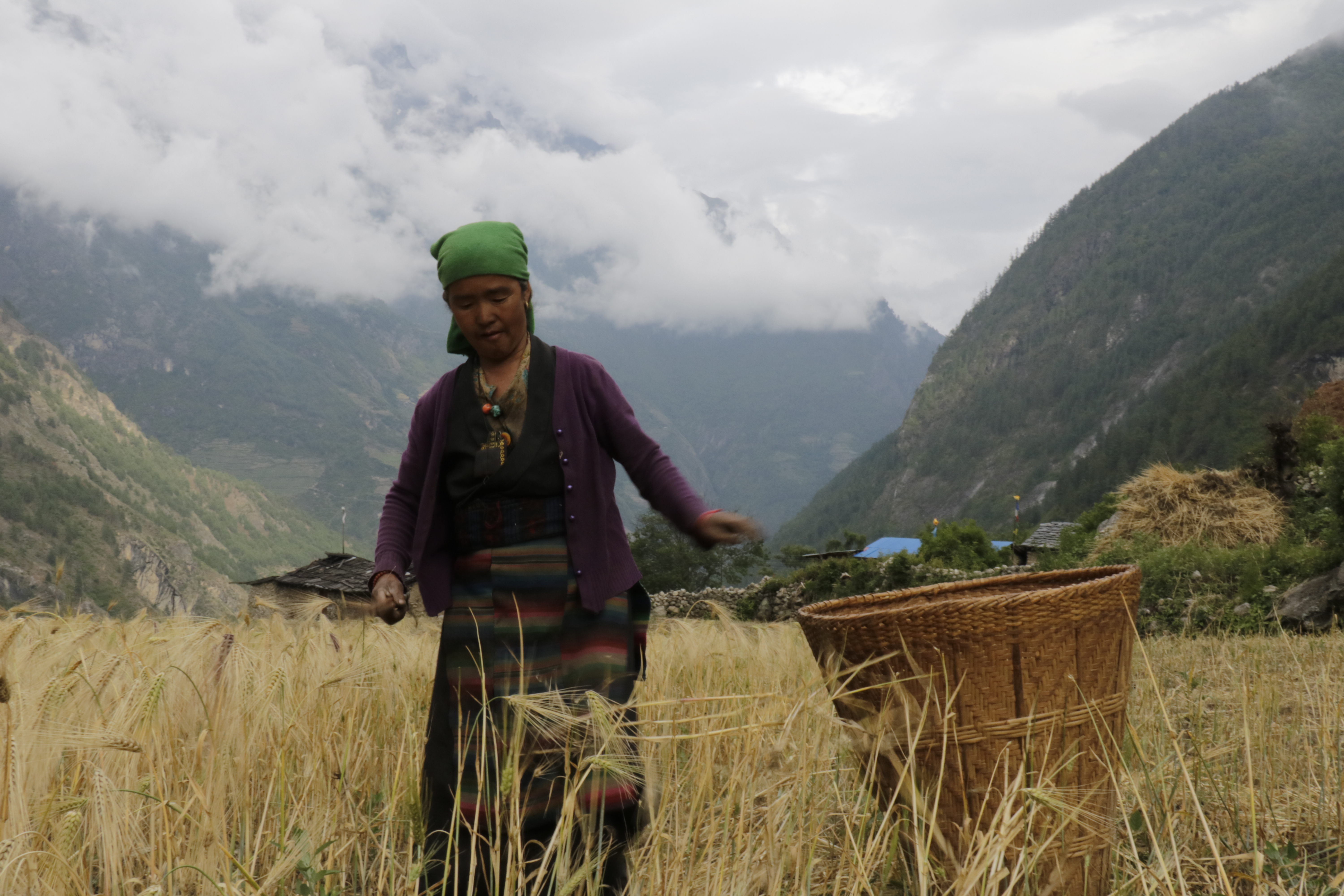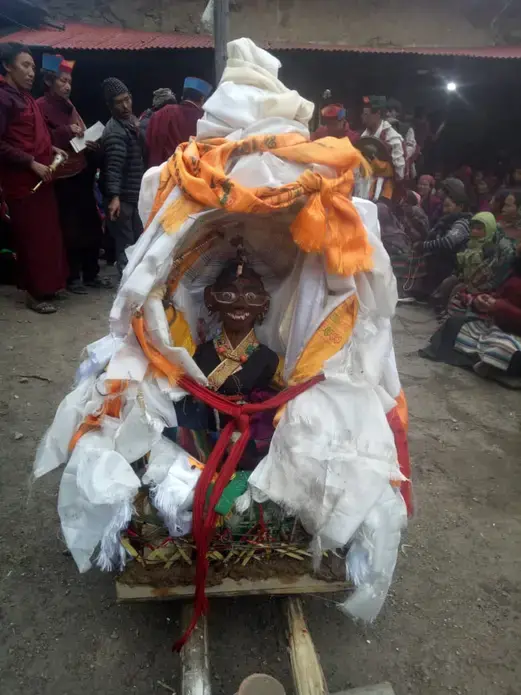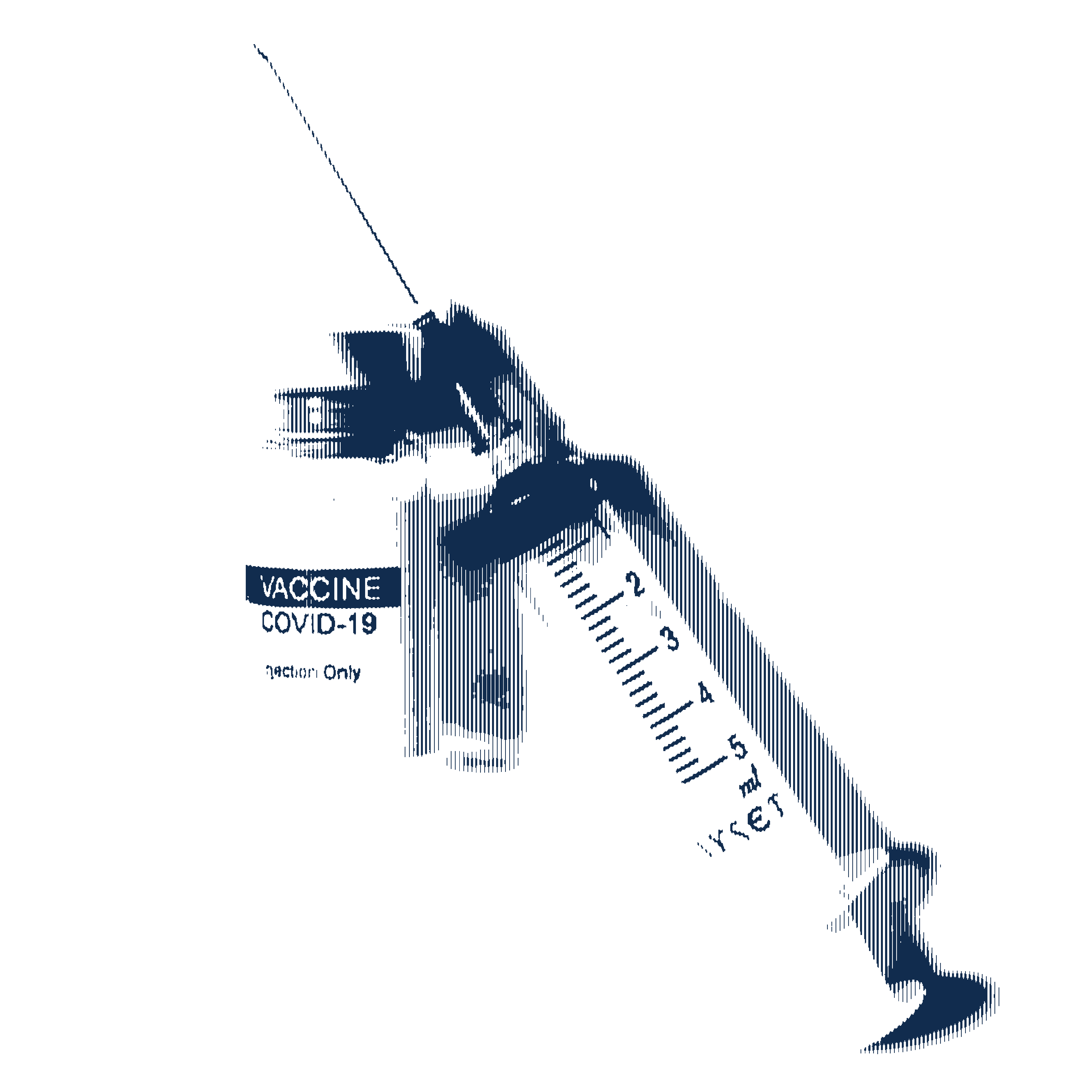Tsering Thinley, a 63-year-old, was born and raised in Trok, Nubri. Trok is a plateau village with a population of approximately 300 people in the Northern Himalayas of Nepal. People living there rely on agro-pastoralism and follow Tibetan Buddhism.
In Trok, Thinley is known among the villagers as a lay Buddhist practitioner, a good friend, an active farmer, and a man with a creative hand for carpentry and embroidery skills. He is also recognized for his singing voice and explicit humor. As he neared retirement age, Thinley and his wife, Nelta Sangmo, moved down to Pokhara, a metropolitan city, to live with their son, Jinpa Tharchen, daughter-in-law, and two grandchildren.
This remote interview was conducted through a Messenger video call and recorded on June 4, 2020. The interviewer and interviewee's choice of language was Tibetan.
Kunsang Choden: What do you think is the cause of COVID-19?
Tsering Thinley: An evil spirit causes the disease, which in turn is caused by humans engaging in different behaviors. Thus, different diseases start. Diseases that even doctors cannot identify the causes of, and even the lamas' Kurim [religious prayer/ritual to ward off illnesses] do not work. These misfortunes are predicted in our Buddhist scriptures, and I think such a time has come.
KC: Where can we find this scripture, and where is it written?
TT: It is written in Orgen Namthar. This written scripture is Guru Rinpoche's Loungten [prophecies] about the future.
KC: From your perspective, what do you think is the cause of this disease?
TT: We would not know where and how this disease has come about. At our individual level, we pray to the three Buddhas, and read Buddhist scriptures with the hope that our families and all the sentient beings will receive benefits from it.
KC: What kind of Puja(s) [mantra recitation and ritual ceremonies]?
TT: Whatever scriptures we have in our yul [hometown]. The most important of the scriptures is Kankyur [sacred Buddhist text]. I prayed to the Jhigzin Drolma [name of a female deity in Tibetan Buddhism], recited Dolma Tong Tsar, made wishes to Guru Rinpoche [Padmasambhava] by reading Samba Lundrup [wish fulfilling prayer] and Barche Lamsel [obstacle removal recitation].
I have been reciting mantras every day, with the hope that if we pray to the Buddhas, we will be protected from this disease. I set my hopes on the Buddha dharma. It is said that calling upon the Guru, the teacher, will protect us from such misfortunes. With this, I lay my hope in it (ends with a burst of big laughter).
KC: Why do you read the Kankyur?
TT: Kankyur is an essential scripture in our Yul. It falls in the category of big Kurim [ritual ceremony]. Now there is a thing called Tso zog, deepa jhang, which means to clear ourselves from the sins of our past and our present and to attend good merit in this lifetime, we recite these prayers. It is done not to benefit myself or to become a rich man.
KC: Where did you first hear about this disease [COVID-19]?
TT: In bayul [Kathmandu].
KC: What did you think and feel when you first heard about COVID-19?
TT: When I first heard about the disease and understood that it started in China, the nation that sentenced numerous Tibetans into imprisonment, and have no thim [rule] against such acts, I felt that they are experiencing lae ghumde [outcome of past action or karma]. I did not think that it would spread to other countries as well. They [China] destroyed a lot of lha-khang(s) [temples], ill-treated choepa(s) [Buddhist monks], and killed numerous lamas [monks]. Thus, my feeling to this was the return of the lae [karma].
KC: Yes, now the disease is everywhere.
TT: Yes, but those who have faith in the dharma, there is less death among the Boe-rigpa(s) [Tibetans/highlanders]. There must be a protector (smiles). Study carefully about this. I think there are not many struggles among those who believe in dharma. I don't know. Yul tha-khyop [bordering land] like the Indian border, they don't have much idea about the dharma or the lamas' blessings. There, people are ignorant about mantra recitation. I hear a lot of such people have died. People trying to enter bayul [Nepal] to find a place to live. Bayul has a lot of Nae [pilgrimage sites], a place of dharma. Many people run here.
I think the disease will soon subside. I hear that this disease will subside in the summer and come back in the colder months?
KC: If this disease is to spread in your family, what methods will you implement to treat it?
TT: Well, even experienced doctors are not able to find a cure for this disease. If we suffer from this disease, it is because of our past karma, meditating upon our karma and letting go will be the only way to accept this disease. It is our lae [karma], because of our bad karma, we die before time. What can we do about this? ...But before we get sick from this disease, it is crucial to recite prayers to the Buddhas for protection and prevention. If you cannot protect us now, when will you? Sometimes quarrel with the Buddhas (laughs jokingly).
KC: Whom should we approach first? Nurse, amchi [doctor], or the lama [spiritual leader]?
TT: If we catch the disease, we need to go to the amchi. Lama cannot protect us from this disease. There are different types of diseases. If doctors cannot protect their patients from the disease, there is no other way. Then it is in our lae [karma]. One that gets sick and dies, even Buddhas cannot protect from such an occurrence.
Tsae dui la bab na,
Amae pangla shi do ki re,
Tsae dui la ma bab na,
Da gi lag la, thar gi re.
[If the death has landed on you, you will die even if you are on your mother's lap. If the death has not landed on you, you will be able to run away even from an enemy's hand.]
A mother is always loving, yet you will die. If it is not your time [to die], even if your enemy comes to kill you, you will be able to get away with it. We do not die easily. We die when it's time for us to die.
KC: Are you saying that for protection you go to the lamas first?
TT: Now, for this situation, we call upon the lamas, the Buddhas. If God can see our obstacles and remove us from our obstacles, they will do it, if doctors can cure our illness, it will. If all these protection mechanisms work together as one, we can find a cure from this disease if it is not our time to die. If it is time to die, even a doctor's child also dies. What can we do about it ? The doctor dies; his wife also dies. It means this obstacle has landed on the death or the devil [dui la bab]. There is no prevention of death.
We perform kurim [ritual ceremony] because it is our wish and hope to live long and gain protection from obstacles. We have hope that we can receive protection from such obstacles.
Going to the hospital is also the same. Those with sufficient monetary resources can change their heart, kidneys, and eyes. Now those with less resources, they cannot enjoy similar privileges. Yet, if it is not time for them to die, even those with no legs but with just their hips and above body functioning, we see them roaming around with a red and bright chubby face (ends with a smile, laughter). It means the disease has not occurred in the dui [devil/death]. If your lae is over, wherever you are, you have to go. If it is not the time for your lae, then you live.
KC: What do you think about the combination of both dharma influence and medical influence? Do you think the combination of these two will have a better impact?
TT: Of course the combination will result in a bigger impact. Thap [skillful means] and sherap [wisdom] always have a bigger impact. Thap and sherap, thap comes from the lama. If you call upon the lama, you can receive protection from these obstacles, and also find a better way towards your next life. Sherap, you receive it from the doctors. It is through such knowledge they discover different types of medicine. They identify the uses of such medicine, and side effects. Therefore, thap and sherap, thapshe sungdel, the combination of the two work together as one. It is neither an outcome from the lama alone, nor the doctors alone. When the lama and the doctors work together, there is hope for a longer life.
KC: Looking back into your life experiences, can you recall about the disease history in Trok, Nubri?
TT: In the past, our people were poor; our eating habits were also poor. We didn't have many amchi [doctors] other than the few village amchi. We had doctors that collected herbs and had many monks. During that time, nae luung [air related illness] is something that comes with you from your mother's womb. We had medicine for luung [air disease]. We had medicine for barken [gastric] and dhangwa [cold disease]. Dhangwa is caused when you are left in the cold for a long time with no clothes. Sometimes you eat expired meat. In that case, there is medicine to subside the heat from the body, medicine for tse-luung [heat-air].
Then we had no idea about cancer or blood pressure. When I was in the village, there was no way to even hear about such diseases. Now there are many doctors. They have named numerous diseases with names. People may have such diseases, yet, when I was in the village, there were not many names for diseases. When you have bad blood, blood is taken out. You have fever, you take fever medicine. You have gastric, you are given gastric medicine. You have dangwa, you are given dangwa medicine and dor [meat protein] for early recovery. You have luung [air], you are given alcohol. You drink it (laughs).
If you have eaten rotten meat; the disease has turned into tse-luung, you cannot eat meat again. In that case, you are given anti-heat medicine. There were no sophisticated names for diseases. Nowadays, every year, they come up with nine to ten names for diseases. These are all made by doctors' tsemma rigpa [medical knowledge]. Even you can name various diseases and come up with medicine if you are a physician.
KC: What are the shapten(s) [Buddhist rituals] performed by the people of Tork regarding this disease?
TT: Now, there are various shapten(s). Seeing that 40-50 students live outside of Trok, Jabyang [community member in Trok] gathered the village leaders. He informed them about the seriousness of this disease and encouraged that shapten be done to bring protection to dear ones and try skillful means to ward off the disease from entering the village. They collected donations from the villagers. Parents worked together to perform mamo doe [ritual to pacify evil spirits and diseases]. They threw sadak doe. It is done to find protection from obstacles. Here, where we do not know the disease, its names, or know what to do about it. If you throw away the doe, the evil spirit will leave and go to its own place. Along with lay monks from Trok, they requested Tulku Jigmey Rinpoche [incarnate monk] from Serang monastery [day-long distance from Trok]. It was five days of ritual performance. Two days of ritual preparation by village lay monks and three days of ritual performance joined by Rinphche.
KC: How has your living situation changed since the start of COVID-19?
TT: I am getting old. I don't see much change in my life. As long as I get food for my body, it doesn't matter when and where I die. I wish that this disease will not cause harm to the young.














